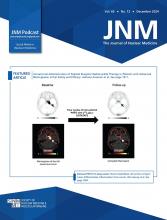TO THE EDITOR: We read with interest the study by Bauckneht et al., who investigated the impact of 3 different radiopharmaceuticals in PET-guided salvage metastasis-directed therapy (MDT) for oligorecurrent prostate cancer, specifically in terms of progression-free survival (PFS), time to systemic treatment change due to polymetastatic conversion (PFS2), and overall survival (OS) (1).
Although the study provides valuable insights, we believe it has significant limitations that hinder the drawing of strong conclusions on this research question.
First, even though the delay in the use of systemic treatments can be considered an indicator of MDT efficacy, androgen receptor pathway inhibitors (ARPIs) have demonstrated improvements in PFS and OS across all high-risk patients with rising prostate-specific antigen (PSA) levels, from nonmetastatic hormone-sensitive prostate cancer to metastatic castration-resistant prostate cancer already treated with chemotherapy (2–5). The MDT paradigm should not represent a way to replace systemic treatment but as a powerful option toward outcome improvement (6). This is especially relevant as systemic therapy now consists of more than just androgen deprivation therapy and is always indicated in this scenario.
Additionally, although it is well-known that prostate-specific membrane antigen (PSMA) PET has a significantly better per-patient detection rate than does choline PET in biochemically relapsed prostate cancer patients with a PSA of no more than 1 ng/mL, previous metaanalyses and studies with histologic confirmation have shown less marked or absent differences for patients with PSA levels comparable to those in this article’s cohort (mean, 2.666 ± 3.56 ng/mL) (7,8). Furthermore, regarding the comparison between [18F]PSMA-1007 and [68Ga]Ga-PSMA-11, we believe that data from this multicenter but retrospective study with a limited number of patients in the 2 arms (n = 44) are insufficient to draw definitive conclusions. A metaanalysis has shown similar accuracy for both tracers in biochemical recurrence, with [18F]PSMA-1007 being superior in identifying local relapses and [68Ga]Ga-PSMA-11 being less prone to, though not exempt from, unspecific bone uptake (9). These data would rationally support better MDT outcomes with [18F]PSMA-1007, at the cost of a slightly increased risk of overtreating benign alterations.
Finally, choline PET guidance was primarily used in the first years of the 2012–2013 interval considered by this paper, whereas PSMA PET was more recently approved in Italy, several years after the introduction of ARPIs into clinical practice (10), which significantly improved PFS, PFS2, and OS (2–6). Concurrent systemic treatment in addition to MDT was prescribed to a significant proportion of patients: 35.80% versus 47.50% in the choline cohort versus the PSMA cohort, respectively. The analysis by year of treatment does not adequately compensate for the lack of a specific analysis of systemic treatments. The nonsignificant difference in patients receiving concurrent systemic treatment in propensity score matching between the 2 cohorts (P = 0.067) needs further assessment, considering that patients treated with the less effective ADT were mostly in the choline era, and patients treated with ARPIs were mostly in the PSMA era.
DISCLOSURE
No potential conflict of interest relevant to this article was reported.
Andrei Fodor, Cristiano Pini*, Gaia Ninatti, Nadia Di Muzio, Arturo Chiti
*IRCCS San Raffaele Scientific Institute Milan, Italy
E-mail: pini.cristiano{at}hsr.it
Footnotes
Published online Oct. 17, 2024.
- © 2024 by the Society of Nuclear Medicine and Molecular Imaging.
REFERENCES
- Received for publication August 19, 2024.
- Accepted for publication August 28, 2024.







